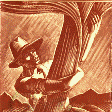Nebraskiana: Resources and Materials on the 37th State
Date of this Version
1893
Abstract
Almost midway between the two greatest oceans of the world, its eastern boundary marked by the rapid flowing Missouri, the westernmost counties shadowed by the towering ranges of the Rockies, with the land of the Dakotas to the north and the great agricultural state of Kansas to the south, lies the garden spot of that vast and shadowy country (which but a few short years since was only known as The Great American Desert).
Today it is the State of Nebraska, the happy home of one million and a half of thrifty, industrious and prosperous people. In less than a third of a century—only a moment in the life of a nation—the rolling prairies, the well watered valleys and the undulating slopes of Nebraska hare been reclaimed from the dominion of the Indian and the stampedes of the buffalo. The early explorers who traversed the continent seem to have been blind to the possibility of a civilization between the Missouri River and the Golden Shores beyond the Rockies. Later on the gold seekers crossed the plains with their bull-trains and heeded not the unbroken land that asked only to be tickled with hoe to smile a harvest.
Later again a few pioneers ventured to this unknown country and, notwithstanding privations that now seem impossible to endure, they sent such glowing accounts of Nebraska, as an agricultural paradise, that the greatest wave of immigration known in the history of America set in from east to west, and the Great American Desert became only a name and a tradition. The virgin soil of Nebraska proved from the beginning especially suitable for corn, and the early settler had a crop harvested in such a short time that the bounty of nature seemed to him to pass belief when he saw the marvelous result of his first labor. What one man did, so did another. Corn was crowned king of Nebraska, and in 1891 there were no less than four million six hundred thousand acres devoted to his service in the State.
The corn crop of Nebraska may well be deemed a guarantee given by nature to the pioneers, insuring them a living while they were settling the State, for those who were to follow them, and making ready the land to produce a wealth and variety of crops the bare enumeration of which almost taxes belief.
Before dealing with the unequalled resources of Nebraska in detail, it may be well to say that the life of the State has developed with marvelous rapidity. It has been no mushroom growth, but a rational, logical advance in all things that go to make up a free and liberal commonwealth. Railroads gridiron eighty-one of its ninety counties. Cities have been born and have grown with healthy vigor. Education is amply provided for in schools whi9ch dot every township. Churches of all denominations rear their spires and cupolas to the clear sky. The city and county governments are enlightened and progressive. Even the advantage of climtate is added, and no clearer air can be breathed, no such regularly diversified seasons, each with its own importance to the State, can be enjoyed as in this, the most generously blessed of all the States—Nebraska.
It is the purpose of this pamphlet to show very briefly, and without the wearying addition of statistics some of the advantages and resources of Nebraska. The State extends a hearty welcome to all who make it their home, relying upon the co-operation of every immigrant to make Nebraska the model State of the West.


Comments
Prepared and compiled by Jos. Garneau, Jr., Commissioner General, Nebraska Columbian Exhibit, 1893. Rees Printing Co., Omaha.